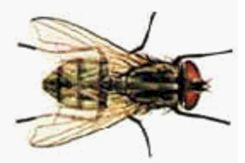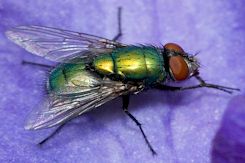


|
|
Fly
 |
 |
 |
| Common Name | Dog dung fly |
| Scientific Name | Musca sorbens |
| Size | These flies are small, they have a length with ranges from 6-8 mm |
| Colour | Musca sorbens are greyish-brown in colour |
| Description | Musca sorbens is selective it does not enter homes and darkened
areas. And it is not attracted to fresh food; it is attracted to garbage
instead. It prefers to feed on cow dung and dog faeces. It looks like a
half-sized house fly, but it characterised by its shiny two-stripped
thorax. It keenly feeds on human eyes and on nasal discharge and
intentionally moves from eye to eye. Musca sorbens is more attracted to wounds, sores, skin lesions searching for food like, blood and other exudations. Even though they don’t bit, they are capable of transmitting eye and diarrhoeal diseases to humans and livestock due to pathogens. |
| Habitat | Musca sorberns reside in solid faeces lying on the
ground. |
| Lifecycle | A total of 42 eggs are laid and they hatch in 10 days. The first growth stage: larvae burrow through the dung and remain there until they mature. The three larval growth stages complete development in 4-5 days, it feeds on the dung. Mature larvae leave the dung during the night and pupate during the day. In about 5 days adults begin to emerge during the late afternoon or early afternoon. In adult stage: a high number of females emerge during the first night |
| Disease Transmitted | Musca sorbens transmits Chlamydia trachomatis which causes trachoma.
Trachoma. |
| Symptoms | Stage 1: early symptoms: - Eye redness, watering eyes, swollen eyelids, sensitivity to bright light. Stage 2: about 7 to 10 days later: - Eyelid small red lumps. Stage 3: Progression of eyelid lumps for a period of 3 to 4weeks: - Multiple eyelid lumps,enlarging eyelid lumps. Stage 4: Spread to cornea and eye: - Eye pain, corneal scaring, progressively dimming vision. |
| Type of Damage | A chronic follicular conjunctivitis that
leads to scarring in the conjunctiva and cornea. It causes corneal
ulceration and corneal opacities resulting in decreased vision and
blindness. |
| Sources / Breeding | Pastoral homesteads provide sufficient breeding sites The females lay their eggs on cracks and clefts of the dung in cluster of over a hundred. Females are capable of multiple egg laying; they complete two ovarian within two weeks. A female deposits an average of 42 eggs each cycle. The number of eggs laid by a female depends on the following factors: female size, longevity, and nutrition. Eggs hatch in about 10 days. |
| Prevention | Proper stool disposal in latrines can reduce the chances of Musca
sorbens to invade homes. Musca sorbens can be easily controlled without
the use of insecticides, unless they have unless they have flooded a
farm. This control can be achieved in the long-term if sanitation and
prevention are the bases of the control programme. Trash areas which are outdoors must be kept clean. Garbage should be drained and wrapped in plastic bags before they are put in the bins outdoors. Dust bins can be fitted with plastic bags inside and be closed with tight fitting lids. This also reduces odour coming from rubbish. Containers should be washed regularly. Bins should be located far from the house or building. Remove potential breeding material like, mulch, leaves, manure, garbage and animal excreta. Household and livestock-related garbage, dumped at the local landfill, can quickly generate large numbers of flies, especially when the garbage already contains fly eggs, larvae, or pupae. Landfill workers must be aware of this possibility and compact and cover such garbage at least twice weekly. Occasionally, wet farm garbage e.g., wet, spoiled grain; wet, waste from calf pens that is brought to the landfill is loaded with fly maggots and pupae. Landfill workers should be alert to this and immediately compact and cover such material. Thousands of adult flies may emerge from such garbage within a few hours. Moist pet foods left outdoors for several days should be avoided. Fermenting or over-ripe fruit should be removed from the ground. Any potential breeding material should be spread thinly in the field and allowed to dry to prevent fly development. Dispose of animal carcasses (including livestock, pigs, and poultry). Collected carcasses must be removed quickly during the summer. Otherwise, they will quickly be the source of flies within 24-48 hours. Prevention through exclusion Flies seem to be able to find their way into homes, garages, shops,
and bins through the smallest of overlooked entrances. Even when all
windows have good screens, when all doors have screened storm doors, and
when all known cracks and crevices have been filled with caulking, the
odd fly seems to get inside the home. Just everyday coming and going
through the back door allows agile flies to get inside the home. Manure Management Solid animal waste which is collected from enclosures for confining
livestock should be dried off quickly and be used as compost for
agricultural purposes soon after drying. Clean cattle pens, drainage
areas, loafing sheds, stalls, feeding aprons, spilled feed, pet
droppings, and other decaying organic matter at 10-day intervals to
minimize fly breeding. |
| Control |
Control with the use of fly swatters and tapes Swatters can be used in doors to eliminate the flies that have invaded the building. Tapes should be used in verandas and garages to trap the flies. Vacuuming control Flies found inside in the fall may also be removed with a vacuum. Because flies are drawn to light, attract them to a bright window in an otherwise darkened room, making it easier to vacuum them. This method is especially useful in cluster fly control. Control with electric light traps Electric light traps are also effective; they can be used in homes. Some are designed to be unobtrusive, mixing in with the décor. They are more ineffective outdoors. Chemical Control Pyrethrums and other chemicals can be used. |
[ Home Page ]